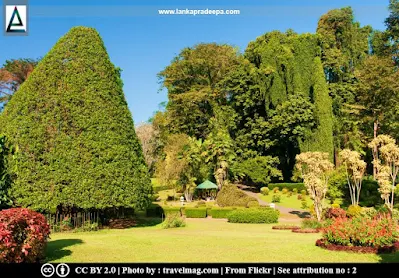
Royal Botanical Gardens, Peradeniya (Sinhala: රාජකීය උද්භිද උද්යානය, පේරාදෙණිය; Tamil: பேராதனை தாவரவியற் பூங்கா) is one of the botanical gardens in Sri Lanka. The garden is located in Peradeniya, about 6 km to the southwest of the Kandy town. It is considered one of the few classic botanic gardens in the world.
History
As suggested by Sir Joseph Banks, a garden named Kew was established in 1810 on a land area of 7 acres in Slave Island, Colombo and William Kerr was appointed as its superintendent (Fernando, 2003). Considering the limit of the land and the flood situation that affected the garden frequently, in 1813, the garden was moved to Uggalbada in Kalutara (Fernando, 2003: Gunawardena, 2003). Kerr died in 1814, and Alexander Moon assumed the duty as the new superintendent in 1817 (Fernando, 2003). It was later realized that Peradeniya has a favourable and better-adapting environment for the proposed botanic establishment and therefore, Moon took the necessary measurements to move the garden to Peradeniya. Finally, in 1821, six years after British annexed Sri Lanka, the Kalutara garden was moved to Peradeniya (Gunawardena, 2003) and it is said that the transfer of exotics from Kalutara to Peradeniya was made by successive superintendents at least up to 1843.

However, the history of the present site where the garden has been established is running back to the reign of King Vickramabahu III [(1357-1374 A.D.) Abeywardana, 2004]. After ascending the throne of Gampola, he kept his court at Peradeniya near the Mahaweli Ganga river. Later, King Kirti Sri Rajasinha (1747-1782 A.D.) made a royal garden there and King Sri Rajadhi Rajasinha (1781-1798 A.D.) resided therein, where a temporary residence was erected for him (Abeywardana, 2004). During the reign of King Vimaladharmasuriya, a temple was built but it was destroyed by the English when they occupied Kandy. It is said that a priest resided there until the Royal Gardens was formed at the present site by Alexandar Moon in 1821.
In 1844, George Gardner was the newly appointed superintendent. During his period many improvements were done to the garden. After his death in 1849, Dr Thwaites became the superintendent and he served until he resigned in 1879. During his period, two botanical gardens: one at Hakgala (1861) and the other at Henarathgoda (1876), were established in order to introduce cinchona and rubber into the island. Henry Trimen succeeded Thwaites in 1879 and served until his death in 1896. Trimen was succeeded by J.C. Willis in 1896.
The site
Bordered by the Mahaweli Ganga river, the garden is the largest botanical garden in the country. It is extending nearly 147 acres (59 hectares) of land area and contains over 4000 species. The altitude of the garden is 550 m (Abeywardana, 2004).
Since 1822, the garden preserves dried herbarium specimens (Abeywardana, 2004). It is also responsible for the propagation of ornamental and endemic plants in the country. Presently, the finance and the administration of the garden are managed by the Department of National Botanic Gardens. Also, this botanical garden has a satellite garden in Ganewatta in North Western Province, which is mainly being used to conserve medicinal plants.
Since 1822, the garden preserves dried herbarium specimens (Abeywardana, 2004). It is also responsible for the propagation of ornamental and endemic plants in the country. Presently, the finance and the administration of the garden are managed by the Department of National Botanic Gardens. Also, this botanical garden has a satellite garden in Ganewatta in North Western Province, which is mainly being used to conserve medicinal plants.
See also
Attribution
References
1) Abeywardana, H.A.P., 2004. Heritage of Kandurata: Major natural,
cultural and historic sites. Colombo: The Central Bank of Sri Lanka. pp.37-38.
2) Fernando,. M., 2003. Kalutara (In Sinhala). Thejani Publications. ISBN:955-8818-00-3. pp.186-187.
3) Gunawardena, C.A., 2003. Encyclopedia of Sri Lanka. Sterling Publishers, New Delhi. ISBN: 81 207 2536 0. p.39.
2) Fernando,. M., 2003. Kalutara (In Sinhala). Thejani Publications. ISBN:955-8818-00-3. pp.186-187.
3) Gunawardena, C.A., 2003. Encyclopedia of Sri Lanka. Sterling Publishers, New Delhi. ISBN: 81 207 2536 0. p.39.
Location Map
This page was last updated on 18 January 2023

